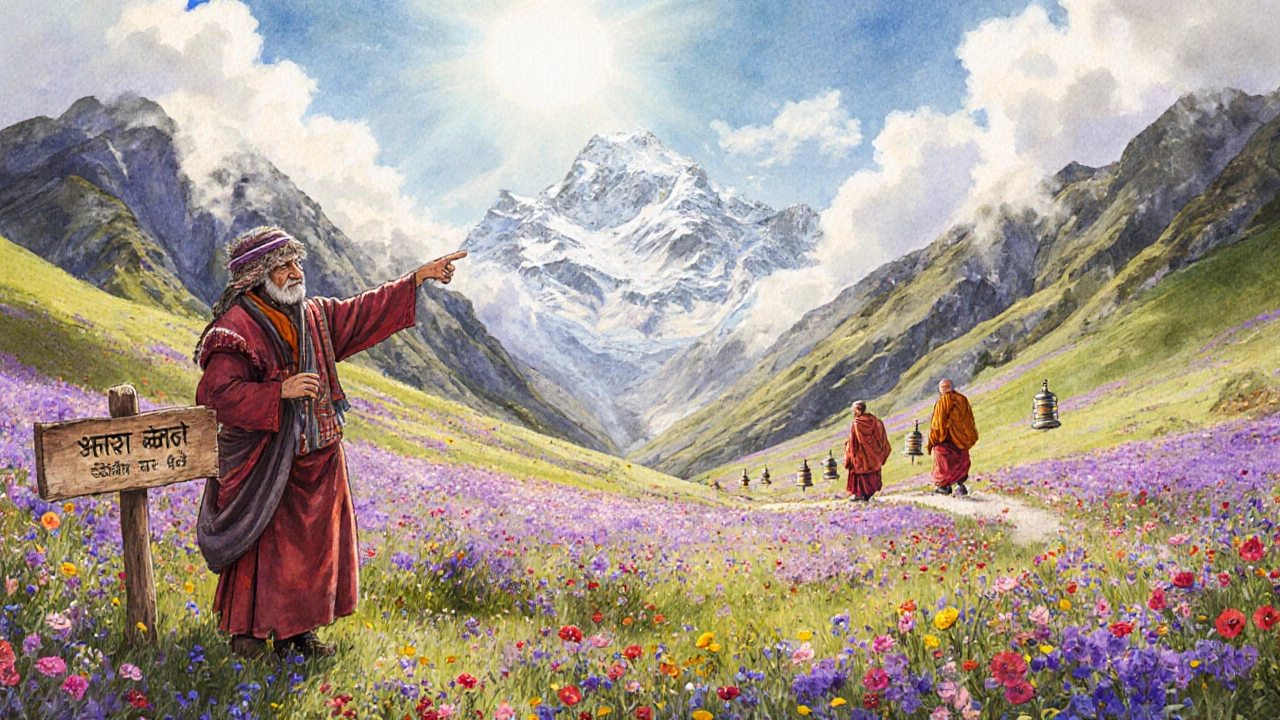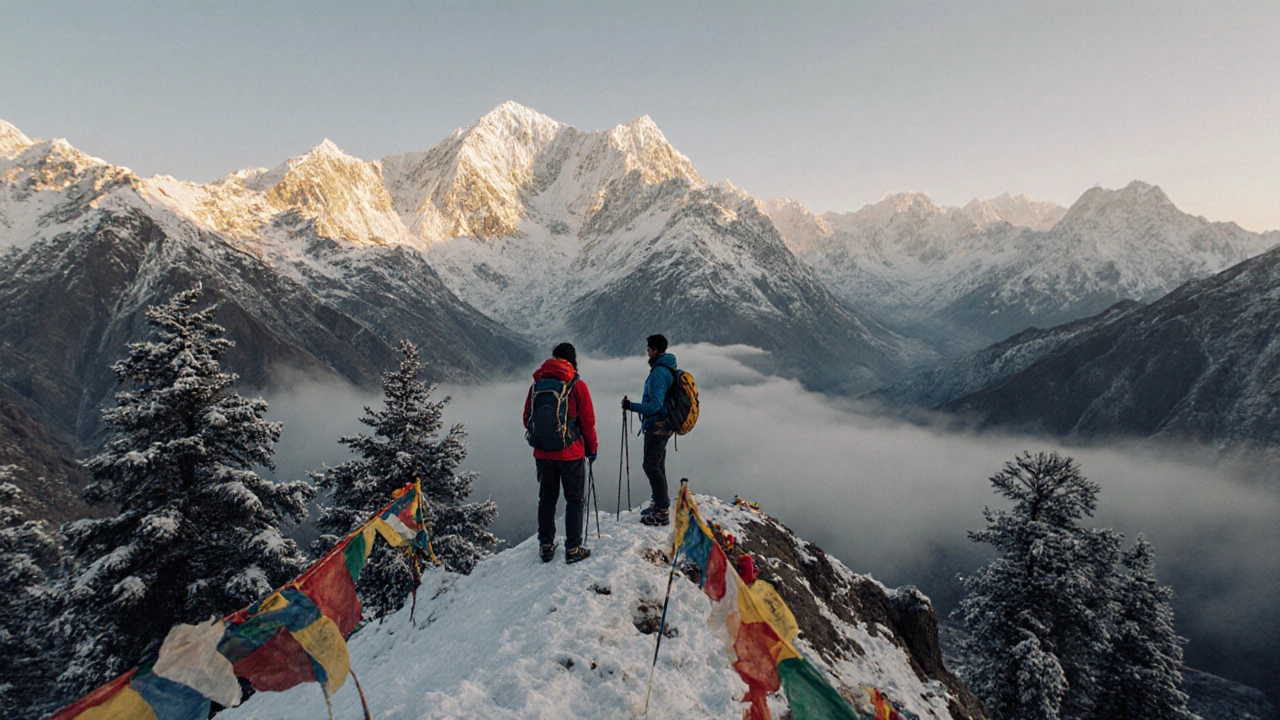Trekking Cost Comparison Calculator
How India Compares
| Destination | Estimated Cost | Savings vs India |
|---|---|---|
| Swiss Alps | $0 | -80% |
| Nepal | $0 | -60% |
| New Zealand | $0 | -85% |
Ask anyone who’s hiked the Himalayas, crossed the Annapurna Circuit, or summited Sandakphu at sunrise, and they’ll tell you one thing: India isn’t just a trekking destination-it’s the world capital of trekking.
Why India Owns the Title
No other country on Earth offers the sheer variety, altitude, culture, and accessibility that India does for trekkers. From snow-capped peaks above 6,000 meters to jungle trails in the Western Ghats, India’s terrain is a trekker’s dreambook. You can walk through ancient monasteries in Ladakh one day and sleep under stars in the Nilgiris the next. The Himalayas alone stretch over 2,500 kilometers across northern India, with over 1,200 named trekking routes. That’s more than Nepal, Peru, and Switzerland combined.What makes India different isn’t just the mountains. It’s the people. Villages along the Roopkund trail still serve hot dal and roti to trekkers in exchange for a few rupees. In the Valley of Flowers, you’ll meet local guides who’ve walked these paths since they were kids. These aren’t commercialized tour stops-they’re living cultures shaped by centuries of mountain life.
The Trails That Define India’s Claim
Not all treks are created equal. India has trails that have become benchmarks for global adventurers.- Hampta Pass in Himachal Pradesh: A 5-day trek crossing from the dry, lunar-like landscape of Kullu into the emerald green valleys of Lahaul. You cross a 4,270-meter pass with views of seven snow peaks.
- Kedarkantha in Uttarakhand: A beginner-friendly winter trek with 360-degree views of the Himalayas. Over 10,000 trekkers hit this trail each winter, making it one of the most popular in the country.
- Valley of Flowers: A UNESCO World Heritage Site where alpine meadows bloom with 500+ species of wildflowers between June and September. The trail starts in Govindghat and ends at the valley-just 11 kilometers, but unforgettable.
- Markha Valley in Ladakh: A 7-day high-altitude trek through Buddhist villages, monasteries, and river gorges. At 4,800 meters, it’s tough-but the sky is so clear you can see the Milky Way like never before.
- Kokan Kada in Maharashtra: A monsoon trek through waterfalls, dense forests, and steep cliffs. It’s the only trek in India where you walk behind a 30-meter waterfall.
These aren’t just hikes. They’re journeys through time, culture, and nature that no other country can replicate at this scale.
Accessibility: Trekking for Everyone
Some countries limit trekking to elite athletes or require expensive permits and gear. India doesn’t. You can start trekking here with a pair of sneakers and a backpack. Many trails, like Kedarkantha or Nag Tibba, are doable in 2-3 days with no prior experience. Local operators charge as little as ₹2,500 ($30) for a full package-food, guide, camping gear, and permits included.And the infrastructure? It’s growing fast. Over 200 registered trekking companies operate in India, with most offering English-speaking guides. You’ll find basic guesthouses, hot showers, and even Wi-Fi on popular routes like the Valley of Flowers. In contrast, remote trails like the Dzukou Valley (Nagaland-Manipur border) remain untouched-perfect if you want solitude.

Seasons That Work for Everyone
Unlike countries with narrow trekking windows, India has trails open year-round. In winter (December-February), the snow-covered trails of Kashmir and Himachal draw crowds. Spring (March-May) brings wildflowers to the Western Ghats and the Himalayan foothills. Summer (June-August) is monsoon season-ideal for waterfalls in Maharashtra and Meghalaya. Autumn (September-November) is peak season for the Himalayas: clear skies, cool air, and stable weather.There’s no bad time to trek in India. You just need to pick the right trail for the season.
Cultural Depth You Won’t Find Elsewhere
Trekking in India isn’t just about physical challenge. It’s spiritual. You’ll pass ancient shrines, mani walls carved with prayers, and monks chanting in monasteries built into cliffs. In Ladakh, trekkers stop to offer barley flour to the wind-a ritual older than Buddhism. In Sikkim, you’ll meet locals who believe every mountain has a deity. These aren’t tourist performances. They’re part of daily life.Compare that to the Alps or the Rockies. You’ll see hikers, but rarely hear chants, see prayer flags, or taste local barley beer served by a grandmother who’s never left her village. India turns trekking into a cultural immersion.
Cost Efficiency: Trekking Without Breaking the Bank
Let’s talk numbers. A 7-day trek in the Swiss Alps can cost over €1,200. In Nepal, it’s around $600-$800. In India? You can do the same length of trek for $150-$250. That includes permits, food, transport, and accommodation. Even luxury treks-think private guides, hot meals, and cozy tents-cost less than half of what you’d pay elsewhere.Why? Because labor, food, and gear are locally sourced. There’s no need to import tents from Germany or hire foreign guides. Local communities run the show-and they’re happy to share their land.
Conservation and Responsibility
India’s trekking scene isn’t perfect. Popular trails like Roopkund and Kedarkantha face issues with litter and overcrowding. But the response has been strong. The Indian Mountaineering Foundation now requires trekkers to carry back at least 1 kg of trash. Many operators now use biodegradable soap and solar-powered lanterns. In 2024, over 30 trekking routes in Uttarakhand and Himachal were given eco-certification.There’s a growing movement: Leave No Trace India. It’s not just a slogan-it’s a rule enforced by local guides. If you don’t pack out your waste, you won’t be allowed to trek again.
What Makes India the Capital? The Verdict
The world has other great trekking countries. Nepal has Everest. Peru has Machu Picchu. New Zealand has Fiordland. But only India offers all of this in one place:- Extreme altitude diversity-from 500 meters to over 6,000 meters
- Over 1,200 named trails, from beginner to expert
- Year-round accessibility
- Cultural depth woven into every step
- Unmatched affordability
- Community-run, locally owned experiences
That’s not a coincidence. That’s a legacy. India didn’t just become the world capital of trekking-it earned it.
Where to Start If You’ve Never Trekked Before
If you’re new to trekking, don’t wait for the perfect trail. Start small. Here’s your first 3-step plan:- Try Nag Tibba (Uttarakhand): A 2-day, 10-kilometer trek with stunning views and no technical climbing. Best in April-May or September-October.
- Book with a local operator: Look for ones with Eco-Certified or Leave No Trace India badges.
- Carry a reusable water bottle and a small bag for trash. You’ll fit right in.
Don’t overpack. Don’t overthink. Just go. The mountains in India aren’t waiting for perfect gear-they’re waiting for you.
Is India the only country that can be called the world capital of trekking?
No other country matches India’s combination of scale, variety, culture, and affordability. Nepal has the Himalayas too, but India offers more trails, more seasons, more cultural depth, and far lower costs. Peru and New Zealand have stunning terrain, but they lack the year-round accessibility and community-based trekking networks that India has built over decades.
Can beginners trek in India?
Absolutely. Trails like Nag Tibba, Kedarkantha, and Kuari Pass are designed for first-timers. Many require no prior experience. Guides provide gear, food, and safety briefings. You don’t need to be an athlete-just someone willing to walk for 4-6 hours a day. Most beginners complete their first trek without issues.
When is the best time to trek in India?
The best time depends on the region. For the Himalayas (Ladakh, Uttarakhand, Himachal), September to November is ideal-clear skies and mild temperatures. For the Western Ghats (Maharashtra, Kerala), June to August offers lush greenery and waterfalls. Winter (December-February) works for lower-altitude treks like Kodaikanal or Coorg. Avoid monsoon in the Himalayas-landslides are common.
Do I need a permit to trek in India?
Yes, for some trails. Protected areas like the Valley of Flowers, Roopkund, and the Dzukou Valley require permits. These are usually arranged by your trekking operator. For popular trails like Kedarkantha or Nag Tibba, permits are simple and inexpensive-often under ₹500. Always confirm with your guide. Trekking without a permit in restricted zones can lead to fines or being turned back.
Is trekking in India safe?
Yes, if you follow basic rules. Altitude sickness is the biggest risk on high trails-acclimatize properly, drink water, and listen to your guide. Most operators carry oxygen and first-aid kits. Crime against trekkers is extremely rare. The biggest danger? Underestimating the weather. Always pack rain gear, even in summer. Stick to marked trails and avoid solo hikes unless you’re experienced.
